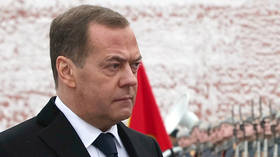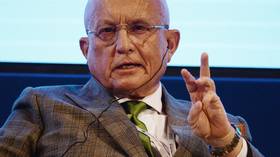Message to the West: What’s behind Russia’s tactical nuclear drills
Moscow’s response comes after escalatory statements by US allies about the Ukraine conflict
Russian President Vladimir Putin on Monday ordered a snap exercise in the use of tactical nuclear weapons in the Southern Military District, which borders Ukraine.
The drill is intended as a warning to the US and its allies not to escalate the Ukraine conflict any further, both the foreign and defense ministries in Moscow emphasized in public statements.
While the West has accused Russia of making nuclear threats on multiple occasions, Moscow’s nuclear doctrine was spelled out in July 2020 and remains unchanged, the Kremlin has repeatedly stated.
Snap exercises
The purpose of the drills is to iron out “the practical aspects of the preparation and deployment of non-strategic nuclear weapons,” as well as to strengthen the readiness of both equipment and personnel, “in order to ensure the integrity and sovereignty of Russia,” the Russian Defense Ministry said on Monday.
The exercises will take place in the Southern Military District, which directly borders Ukraine. Headquartered in Rostov-on-Don, it is the smallest of Russia’s military districts, and includes Crimea, the Caucasus, the regions of Rostov, Volgograd and Krasnodar, as well as the recently admitted Donetsk People’s Republic (DPR), Lugansk People’s Republic (LPR), Kherson and Zaporozhye Regions.
Russia’s tactical nuclear arsenal
Warheads with yields measured in kilotons of TNT – such as the weapons used by the US against the Japanese cities of Hiroshima and Nagasaki in April 1945 – are now considered tactical nuclear weapons. They are intended for use against battlefield targets, whether field formations or hardened combat positions.
Tactical nuclear warheads with yields of 5-50 kilotons can be mounted on 9M723-1 ballistic missiles or the 9M728 cruise missiles, both fired from the Iskander-M complex. Similar warheads can be carried by Kh-47M2 Kinzhal and the Kh-32 cruise missiles that are carried by Russian bombers.
A number of artillery systems can also deliver tactical nuclear warheads in the 2-2.5 kiloton range, installed in 152mm shells and 240mm mortar rounds.
Russia is estimated to have almost 6,000 nuclear warheads of various yields. An unspecified number of tactical nuclear warheads were stationed in Belarus last year, as a response to NATO members delivering depleted uranium munitions to Ukraine.
The US has about 180 tactical nuclear bombs deployed at six bases in Europe – two in Italy, and one each in Belgium, Germany, the Netherlands and Türkiye. The government in Warsaw has expressed a willingness to host the weapons as well, to which Moscow responded that it would consider Poland a priority target.
Message to the West
The tactical nuclear drills are taking place “in the context of recent belligerent statements by Western officials and sharply destabilizing actions taken by a number of NATO countries” in connection with the Ukraine conflict, the Russian Foreign Ministry said on Monday.
The US-led bloc’s policy of inflicting a “strategic defeat” on Russia is leading it towards “a further escalation of the Ukraine crisis towards an open military clash” between NATO and Moscow, the ministry added.
As examples, the ministry cited Polish statements about the possible stationing of US nuclear weapons in Poland, but also recent French nuclear posturing and remarks by President Emmanuel Macron about the possibility of sending French and other NATO soldiers to Ukraine.
Russia’s nuclear doctrine
According to the decree signed by President Vladimir Putin in July 2020, Moscow’s nuclear arsenal is intended to deter external aggression against Russia.
The doctrine is “defensive in nature, aimed at maintaining the potential of nuclear forces at a level sufficient to ensure nuclear deterrence, and guarantees the protection of the sovereignty and territorial integrity of the state, deterring a potential enemy from aggression against the Russian Federation and (or) its allies, and – in the event of a military conflict – preventing the escalation of hostilities and their cessation on terms acceptable to the Russian Federation and (or) its allies.”
Russia views nuclear weapons “solely as a means of deterrence” and considers their use “an extreme and forced measure,” the decree specified.
The doctrine outlines the conditions under which the Russian president would be justified in authorizing the use of atomic weapons. Of particular importance is Section 17, which spells out that Russia “reserves the right to use nuclear weapons in response to the use of nuclear weapons and other types of weapons of mass destruction against it and/or its allies, as well as in the event of aggression against the Russian Federation using conventional weapons, when the existence of the state itself is at risk.” (emphasis added)
Claims and counterclaims
Time and again since the escalation of the Ukraine conflict in February 2022, the US has accused Russia of rattling the nuclear sabers and even considering the use of tactical nuclear weapons against the government in Kiev. Moscow has repeatedly dismissed such claims as groundless speculation.
For example, a CNN reporter claimed in March that Washington began “preparing rigorously” for the possibility of Russia using nuclear weapons in Ukraine in late 2022, as Kiev’s forces advanced in Kharkov and Kherson. However, Russian President Vladimir Putin said in an interview that it had “never come into his mind to use tactical nuclear weapons” despite the “various situations” that had emerged on the battlefield.
In a speech to Russian lawmakers at the end of February, Putin accused the West of flirting with nuclear disaster. “Everything that they are thinking up now, that they are scaring the world with, it all really poses the threat of a conflict involving nuclear weapons, and therefore, the destruction of civilization. Don’t they understand this?” the Russian president said at the time.
Earlier this year, while Congress was debating the $61 billion military aid bill for Kiev, the US floated unspecified accusations about a secret Russian nuclear capability in space. The Kremlin has denied such rumors as scurrilous.







Comments are closed.